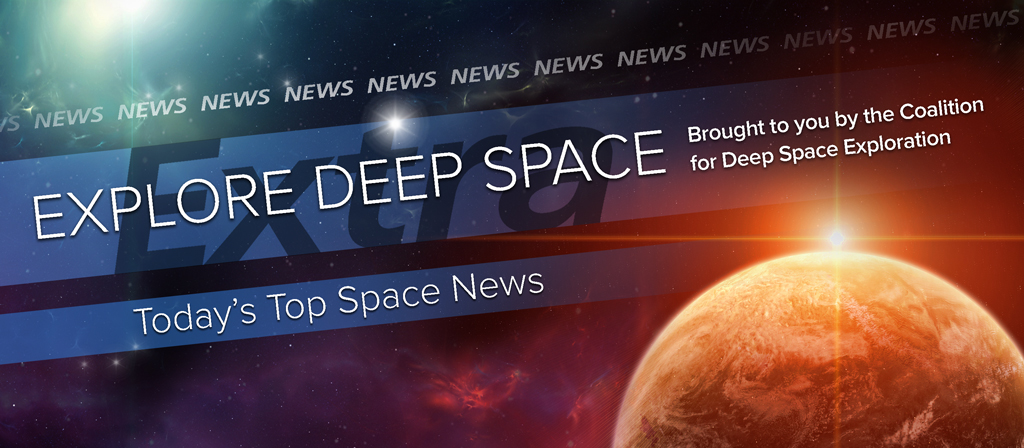In Today’s Deep Space Extra… First lettuce, now zinnias and soon to come tomatoes. Space Station astronauts evaluate plant growth for future human deep space exploration.
Human Deep Space Exploration
Space farmer Scott Kelly harvests first “space zinnia” grown aboard Space Station
Universe Today (2/18): After cultivating romaine lettuce and zinnia flowers aboard the International Space Station with the help of NASA’s marathon astronaut Scott Kelly, NASA intends to grow tomatoes in the veggie greenhouse. Fresh fruit and vegetables could be an important part of the physical and mental health of astronauts assigned to future missions of deep space exploration. Kelly is due back on Earth on Mar. 1, after nearly a year in orbit, the longest single space flight by an American.
China’s racing to space. Is it a military ploy?
NBCNews.com (2/18): China is investing $2 billion to $3 billion annually on space and intends to launch more than 20 missions in 2016. Some will advance efforts to establish a habitable space station by 2022 and reach the moon with astronauts in the mid-2020s. However, Beijing is also pursuing anti-satellite technologies that could pose a national security threat to the U.S.
Space Science
WFIRST gets go ahead
Spacepolicyonline.com (2/18): Plans for a powerful space observatory intended to follow the James Webb Space Telescope have received the go ahead for development from NASA. WFIRST, which will incorporate optics once intended for a U.S. reconnaissance satellite, will launch in the mid-2020s for observations of alien planets as well as the influences of dark energy and dark matter. The JWST is slated for a late 2018 liftoff.
Did a gamma ray burst accompany LIGO’s gravity wave detection?
Universe Today (2/18): Observations of a gamma ray burst that accompanied a distant black hole merger that generated evidence of gravity waves predicted by Albert Einstein’s General Theory of Relativity signal a new mystery. Scientists announced the confirmation of gravity wave observations last week. Was the gamma ray burst a coincidence or related to the merger?
Ancient impacts mysteriously erased from asteroid Vesta
Discovery News (2/18): Main belt asteroid Vesta is not showing evidence of an intense period of space rock impacts during an early epoch of the solar system. Damage from the Late Heavy Bombardment four billion years ago is still evident on the moon and other inner solar system bodies. On Vesta, the scarring was likely erased by more recent impacts, according to studies carried out with observations from NASA’s Dawn mission.
Hubble telescope shows us a “supermassive” black hole
Houston Chronicle (2/18): The famed space observatory, a joint U.S. and European project, spotted a black hole 21 billion times larger than the sun and 300 million light years distant.
Pluto’s moon Charon busted out of its skinCosmos Magazine (2/19): Images gathered by NASA’s New Horizons spacecraft suggest the moon Charon once had a subsurface ocean. As the water froze and expanded over time, ice broke through the crust. The images were gathered during New Horizon’s mid-July flyby of Pluto.
Commercial to Low Earth Orbit
Cygnus ending OA-4 mission at ISS with high praise and success
NASAspaceflight.com (2/18): Launched Dec. 6, Orbital ATK’s latest commercial resupply mission docked to the six-person International Space Station three days later, delivering more than 7,000 pounds of food, clothes and research equipment. The capsule departs the station early Friday, bringing an end to the company’s first cargo delivery since an Oct. 28, 2014 resupply mission loss. The latest mission successfully debuted an upgraded Cygnus with more cargo volume than earlier versions.
Suborbital
Branson’s Virgin Galactic moves to return to space race
Reuters (1/18): Richard Branson is eager to resume efforts to develop a suborbital passenger spaceflight business, the founder of Virgin Galactic said Thursday during a tour of the company’s Long Beach, Calif., design and manufacturing plant. The company is set to unveil its six passenger, two pilot SpaceShipTwo on Friday. Virgin Galactic is recovering from a late 2014 SpaceShipOne test flight tragedy that claimed the life of one pilot and injured the second.

